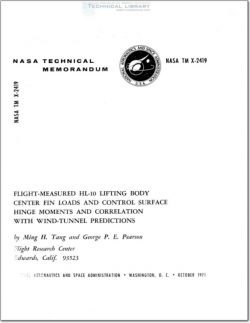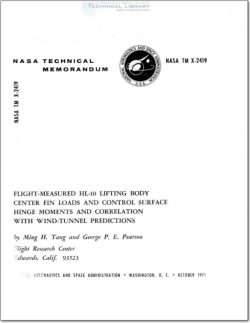NASA-TM-X-2419

- Version
- 238 Downloads
- 1.59 MB File Size
- 1 File Count
- June 15, 2016 Create Date
- June 15, 2016 Last Updated
Flight Measured HL-10 Lifting Body Center Fin Loads and Control Surface Hinge Moments and Correlation with Wind Tunnel Predictions

The HL—10 flight test vehicle (fig. 1(a)) is a low—aspect—ratio (1, 156), wingless
lifting body configuration incorporating a delta planform and negative camber with
three stabilizing fins and four primary and six secondary control surfaces. A three—
view drawing of the vehicle is shown in figure 1(b), and the pertinent physical char-
acteristics are given in table 1.
The control surface pairs are located in the aft region of the vehicle. The split
rudders are moved symmetrically outward as speed brakes or deflected in unison
(i. e. , both rudders moved in the same direction) for yaw control. The two bulk ele—
vons forming the rear portion of the lifting body are deflected symmetrically for pitch
and longitudinal trim control and differentially for roll control. Two elevon flaps on
the upper surface of the two elevons are deployed symmetrically to increase the base
area. In addition, four tip fin flaps at the trailing edge of the tip fins are deflected
to increase the base area.
Configurations A to D as defined by the positions of the speed brakes. elevon flaps,
and the tip fin flaps are shown in the sketches of figure 2. All the flight test load data
presented in this report, except the rudder hinge—moment coefficients, were acquired
with the vehicle in configurations A and B, shown photographically in figures 3(a) and 3(b).
The first 11 flight tests of the HL—lO vehicle were unpowered. Launch of the
vehicle from a modified B—52 airplane at an altitude of 13,700 meters (45, 000 feet) and
a Mach number of 0. 65 to 0.75 was followed by a series of research maneuvers, The
flights were concluded by gliding to a landing on Rogers dry lakebed. The second
phase of the program consisted of a series of flights in which rocket power was used
to expand the flight envelope to a maximum Mach number of approximately 1. 85 and a
peak altitude of approximately 27, 400 meters (90, 000 feet). Research maneuvers to
investigate the subsonic, transonic, and supersonic flight characteristics of the
vehicle were performed primarily during the rocket—engine—off portion of the flight.
The subsonic flight data presented in this report were obtained at Mach numbers from
0.45 to 0, 75. the transonic data at Mach numbers from 0. 85 to 0. 95, and the super—
sonic data at Mach numbers from 1. 15 to 1. 25. The vehicle an le of attack was varied
from 5" to 30°. and the Reynolds number ranged from 3. 5 X 10 to 62 X 106, based on
the vehicle length of 6. 45 meters (21. 17 feet).
| File | Action |
|---|---|
| NASA-TM-X-2419 Flight Measured HL-10 Lifting Body Center Fin Loads and COntrol Surface Hinge Moments and Correlation with Wind Tunnel Predictions.pdf | Download |
Comment On This Post